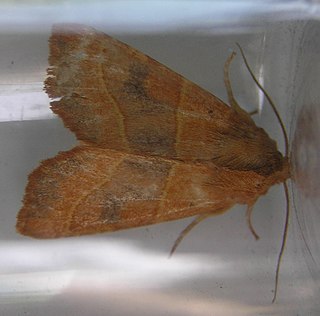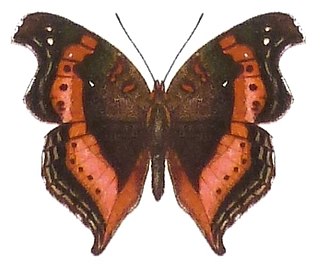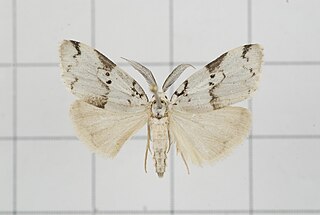Related Research Articles

Dimorphotheca sinuata, the glandular Cape marigold, Namaqualand daisy, or orange Namaqualand daisy; syn. Dimorphotheca aurantiaca hort.) is an African species of plants native to southern Africa. It is also widely cultivated as an ornamental and naturalized in parts of the United States, primarily California and Arizona.

Atethmia is a genus of moths of the family Noctuidae.
Cymatophoropsis is a genus of moths of the family Noctuidae. The genus was erected by George Hampson in 1894.

Laspeyria is a genus of moths of the family Erebidae erected by Ernst Friedrich Germar in 1810.

Psilochira is a genus of tussock moths in the family Erebidae. The genus was erected by Lambertus Johannes Toxopeus in 1948.

Zermizinga is a monotypic moth genus in the family Geometridae erected by Francis Walker in 1863. Its only species, Zermizinga sinuata, the lucerne looper or spider moth, was described by Warren in 1897. It is found in the Australian states of New South Wales, Victoria and Tasmania.
Satronia is a New World genus of tortrix moths belonging to the subfamily Olethreutinae and tribe Grapholitini. The genus was erected in 1926 by Carl Heinrich and was previously considered monotypic. Its type species is Satronia tantilla.

Precis sinuata, the wide-banded commodore, is a butterfly in the family Nymphalidae. It is found in Guinea, Sierra Leone, Liberia, Ivory Coast, Ghana, Nigeria, Cameroon, Equatorial Guinea, São Tomé and Príncipe, the Republic of the Congo, the Central African Republic, the Democratic Republic of the Congo, Uganda, Rwanda, Burundi, Kenya, Tanzania, Malawi, Zambia and Mozambique. The habitat consists of forests and woodland.

Eugoa sinuata is a moth of the family Erebidae. It is found in Taiwan.
Gaurena is a genus of moths belonging to the subfamily Thyatirinae of the Drepanidae. It was erected by Francis Walker in 1865.
Gaurena sinuata is a moth in the family Drepanidae. It is found in Nepal and China.

The Stenomatinae are a subfamily of small moths in the family Depressariidae.
Stenoma ochricollis is a moth of the family Depressariidae. It is found in Guyana, Panama and Peru.
Stenoma strigivenata is a moth of the family Depressariidae. It is found in the Amazon region, Guyana and Peru.

Stenoma is a genus of moths. The type species is Stenoma litura, which was described by Philipp Christoph Zeller in 1839.
Stenoma empyrota is a moth in the family Depressariidae. It was described by Edward Meyrick in 1915. It is found in Guyana.
Stenoma biseriata is a moth in the family Depressariidae. It was described by Philipp Christoph Zeller in 1877. It is found in Central America.
Stenoma exarata is a moth in the family Depressariidae. It was described by Philipp Christoph Zeller in 1854. It is found in Costa Rica, Mexico, Guatemala, Venezuela, French Guiana and Brazil (Amazonas).
Stenoma litura is a moth in the family Depressariidae. It was described by Philipp Christoph Zeller in 1839. It is found in South America.
Stenoma scitiorella is a moth in the family Depressariidae. It was described by Francis Walker in 1864. It is found in Panama, Brazil (Amazonas) and Guyana.
References
- ↑ "Stenoma Zeller, 1839" at Markku Savela's Lepidoptera and Some Other Life Forms.
- ↑ Beccaloni, G.; Scoble, M.; Kitching, I.; Simonsen, T.; Robinson, G.; Pitkin, B.; Hine, A.; Lyal, C., eds. (2003). "Stenoma sinuata". The Global Lepidoptera Names Index . Natural History Museum . Retrieved May 14, 2018.
| This article on a moth of genus Stenoma is a stub. You can help Wikipedia by expanding it. |